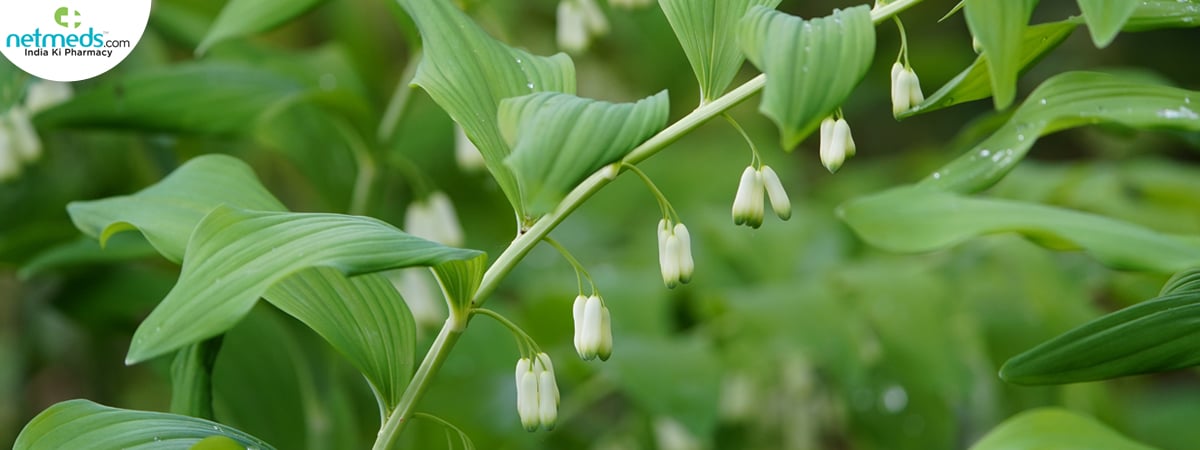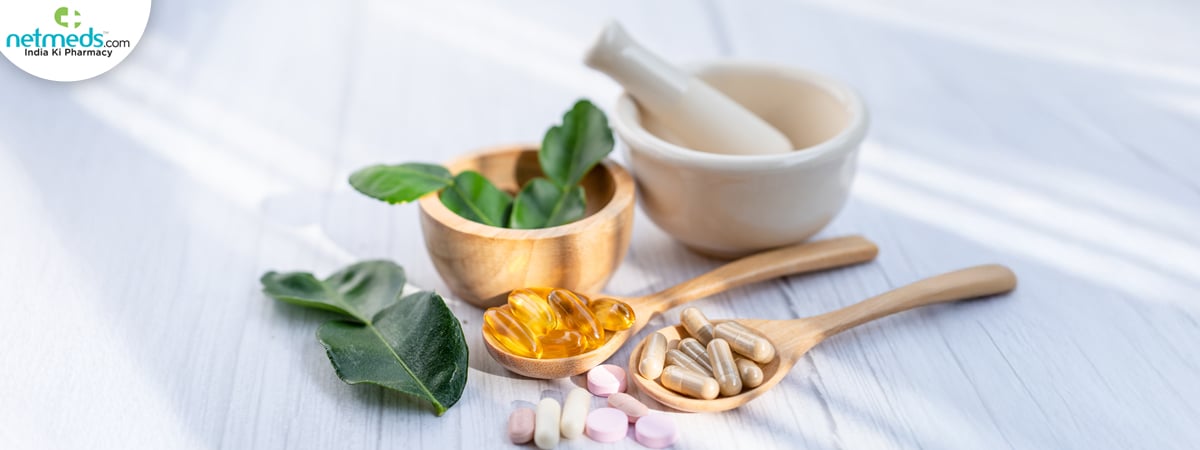Mahameda has been valued in Ayurvedic classics for its rasayana (anti-aging) activity, its body-nourishing nature, and its capacity to cure diseases such as debility, infertility, and joint ailments. With its strength-building activity, the herb is particularly prized in products used for stamina, vigor, and immunity.
Be in the pink of health with our wide range of Ayurvedic supplements today!
In this current health-savvy era, where individuals seek organic remedies to enhance energy levels and fertility and combat chronic fatigue, Mahameda is the strong wellness warrior. From its distinctive botanical profile to its ability to balance doshas, all that you should know about Mahameda (Polygonatum cirrhifolium) is here in this article: Ayurvedic properties, medicinal properties, 10 unbelievable health benefits, dosage, side effects, and precautions.

What Is Mahameda?
Mahameda, or Polygonatum cirrhifolium, is a member of the Asparagaceae family. It is also referred to as Mahameda or Mahamedaka in Sanskrit and is translated as "the great one that nourishes." It is a perennial herb and is frequently related to promoting ojas (the vital life essence) and vigour.
In Ayurveda, Mahameda is found in the list of herbs that act as balya (body strength promoters) and vajikarana (aphrodisiacs). It has been used by traditional practitioners for centuries to treat weakness, reproductive ailments, and arthralgias and as a rejuvenating tonic for general well-being.
Plant Description of Mahameda
Mahameda is a robust perennial herb that grows well in Himalayan and montane forests.
It is usually found growing in shaded, cool locations and is known to have its most utilized part as fleshy rhizomes in Ayurveda. The plant is approximately 40–100 cm in height with a long, arched stem and whorls of leaves. The leaves are oblong-lanceolate, whorled in 3–5, and leathery in texture. The flower is minute, greenish-white to yellow and clustered and occurs in a hanging manner below the leaves. The fruit are berries, bluish-black in color when mature, and the rhizomes are fleshy, succulent, and medicinally worthy.
In Ayurveda, the Mahameda rhizome is regarded as the most valuable portion and is dried and powdered for application in preparations, but leaves and stems sometimes get a place in conventional uses.
Medicinal Properties of Mahameda
Ayurveda values Mahameda due to its extensive array of curative actions. Some of its chief medicinal properties are:
Rasayana: Rejuvenates and restores youthful vigor
Balya: Increases physical strength and endurance
Vrishya: Increases fertility and sexual well-being
Ojovardhaka: Enhances ojas (vital essence) and immune system
Shothahara: Decreases swelling and inflammation
Vedanasthapana: Gives relief from pain
Raktashodhaka: Purifies blood and enhances circulation
Medhya: Nourishes cognition and mental faculties
Ayurvedic Properties of Mahameda
Rasa (Taste): Madhura (Sweet), Tikta (Bitter)
Guna (Quality): Guru (Heavy), Snigdha (Unctuous)
Virya (Potency): Sheeta (Cold)
Vipaka (Post-digestive effect): Madhura (Sweet)
Effect on Doshas: Levelling of Vata and Pitta; potentially aggravates Kapha slightly if excess is taken
These properties render Mahameda especially useful for feebleness, infertility, arthritis, and inflammation but also for mental acuity and immunity.

10 Detailed Health Benefits of Mahameda
Increases Energy and Stamina
Mahameda is a superb balya dravya, as it fortifies the body and enhances stamina. It is used extensively during recuperation after illness to combat weakness and languor.
Maintains Reproductive Health
Since Mahameda is a natural aphrodisiac (vrishya), it aids in enhancing libido, fertility, and sperm quality in males and maintaining reproductive health in females.
Boosts Immunity
Since Mahameda possesses rasayana activity, it boosts the immunity system by strengthening the tissues and raising ojas. This renders the body stronger against infections and chronic diseases.
Also Read: Immunity Boosters: 6 Powerful Herb Infused Concoctions You Must Have For Enhanced Health
Maintains Joint and Bone Health
Mahameda alleviates inflammation and pain in joints. It is usually prescribed for diseases such as arthritis, osteoporosis, and muscular stiffness because of its strengthening effect on bones and connective tissue.
Promotes Skin Health
Its raktashodhaka (blood-purifying) property improves the health of the skin, minimizes blemishes, and controls chronic skin conditions such as eczema and psoriasis.
Increases Weight in the Weak
In contrast to weight loss herbs, Mahameda benefits thin or weak individuals by enhancing nutrition and healthy muscle mass.
Improves Cognitive Function
As a medhya herb, Mahameda benefits the brain, enhancing memory, concentration, and mental clarity. It prevents stress, anxiety, and fatigue-induced brain fog.
Shelters the Respiratory System
Due to its calming and nourishing properties, it is very effective in chronic respiratory problems like cough, asthma, and lung weakness.
Also Read: Respiratory Health: 5 Incredible Herbs To Boost Your Lung Power
Maintains Female Reproductive Health
In females, Mahameda is useful in maintaining menstrual cycles, alleviating weakness during menstruation, and enhancing fertility. It is also employed in a few formulations for recovery after childbirth.
Enhances Longevity and Vigor
By balancing doshas, enhancing ojas, and as rasayana, Mahameda maintains general health, arrests senility, and increases longevity.
Also Read: Ayurvedic Herbs For Stamina: 5 Natural Energizers To Fight Fatigue Fast - Infographic

Dosage of Mahameda
The dosage can vary based on the form and intended use. General guidelines are:
Churna (Powder): 3–6 grams daily with milk or warm water
Kwatha (Decoction): 30–60 ml once or twice daily before meals
Capsules/Tablets: 250–500 mg twice daily (as per manufacturer's recommendation)
Medicated Formulations: Usually taken in combination with other herbs in Rasayana and Vajikarana tonics
Note: Always consult an Ayurvedic doctor for individualized dosage according to your health status.
Side Effects of Mahameda
Mahameda is normally safe in the recommended dose. Yet, abuse or self-administration can cause:
Heaviness or slow digestion (due to Guru guna)
Mild nausea in sensitive patients
Kapha aggravation if abused
Precautions Before Taking Mahameda
Avoid excessive usage if you have slow digestion or excessive Kapha imbalance.
Pregnant and breastfeeding women should only take it under medical prescription.
Individuals with diabetes are advised to check blood sugar because it can affect glucose metabolism.
Talk to your doctor if you are currently on fertility or hormonal drugs.
Conclusion
Mahameda (Polygonatum cirrhifolium) is indeed a stamina-building herb that reflects the Ayurvedic philosophy of wholeness. Whether it's creating stamina, maintaining reproductive health, boosting immunity, or supporting longevity, Mahameda provides various benefits for both men and women.
Including this herb in your wellness plan can assist you in overcoming exhaustion, enhancing vitality, and achieving body-mind balance. As with any Ayurvedic herb, though, it functions optimally with guidance and in moderation.
If you want a natural friend to revive strength, reproductive health, and overall vigor, Mahameda is an effective herb you should adopt on your path to wellness.
Frequently Asked Questions
What is Mahameda used for?
It is utilized for strength, stamina, fertility, joint health, and immunity.
Can Mahameda enhance fertility?
Yes, it is a natural aphrodisiac and promotes reproductive well-being in both males and females.
Is Mahameda safe for everyday consumption?
Yes, when taken in recommended doses under Ayurvedic guidance.
Does Mahameda aid in weight gain?
Yes, it assists weak or malnourished individuals to gain healthy muscle mass.
Can pregnant women take Mahameda?
Only with medical guidance, as overuse could be unsafe.
(This article is reviewed by Kalyani Krishna Chief Content Editor)
Author Profile
Soumita Basu:
Soumita Basu holds a Bachelor’s Degree in Pharmacy and is keenly interested in Ayurveda, home remedies, yoga, fitness, diagnostics, and beauty. With nearly 6 years of experience, she produces evidence-based health content, including articles, videos, and infographics, to provide valuable insights to her audience.
References:
- https://www.researchgate.net/publication/367221142_Study_of_Antioxidant_Property_of_the_Rhizome_Extract_of_Polygonatum_cirrhifolium_Mahameda_and_its_use_in_the_green_synthesis_of_Gold_nanoparticles
- https://www.sciencedirect.com/science/article/pii/S0254629918316673
- https://www.researchgate.net/publication/346278650_MEDA-_AN_IMPORTANT_MEMBER_OF_ASTAVARGA_IS_SUFFERING_FROM_IDENTIFICATION_AND_STANDARDIZATION



 Previous
Previous